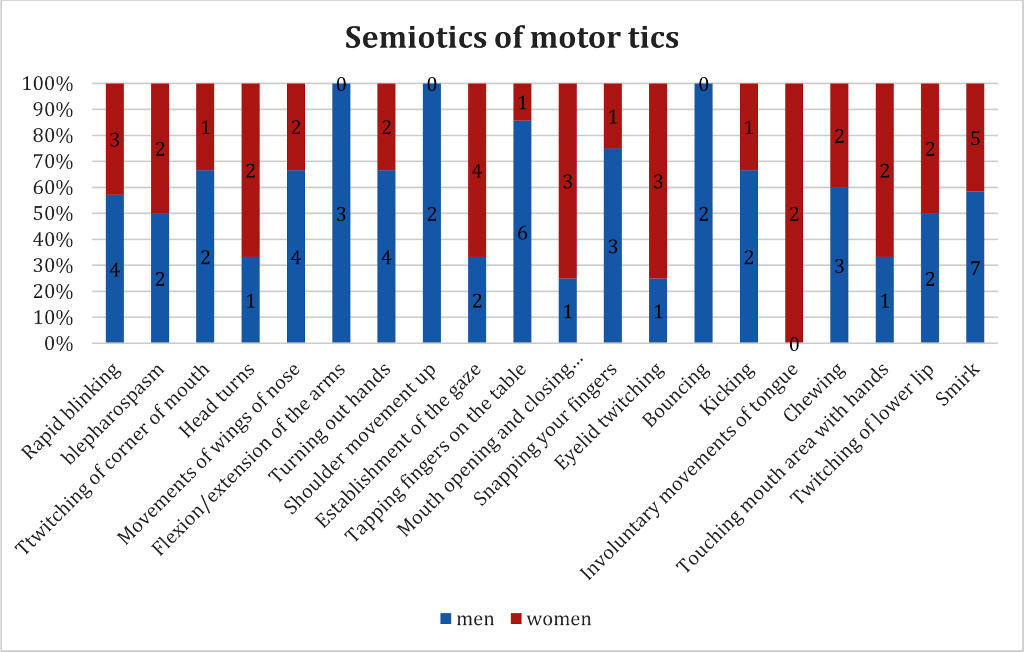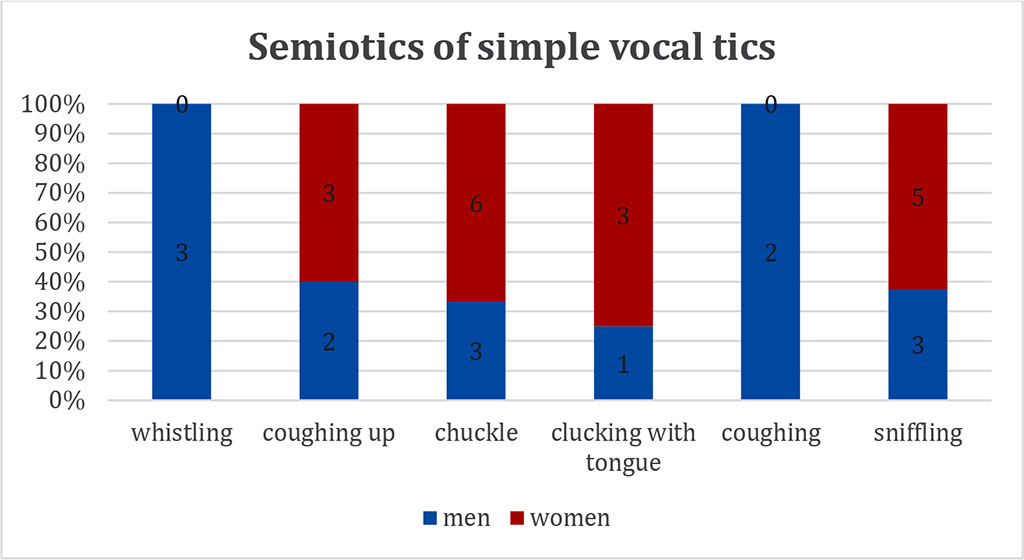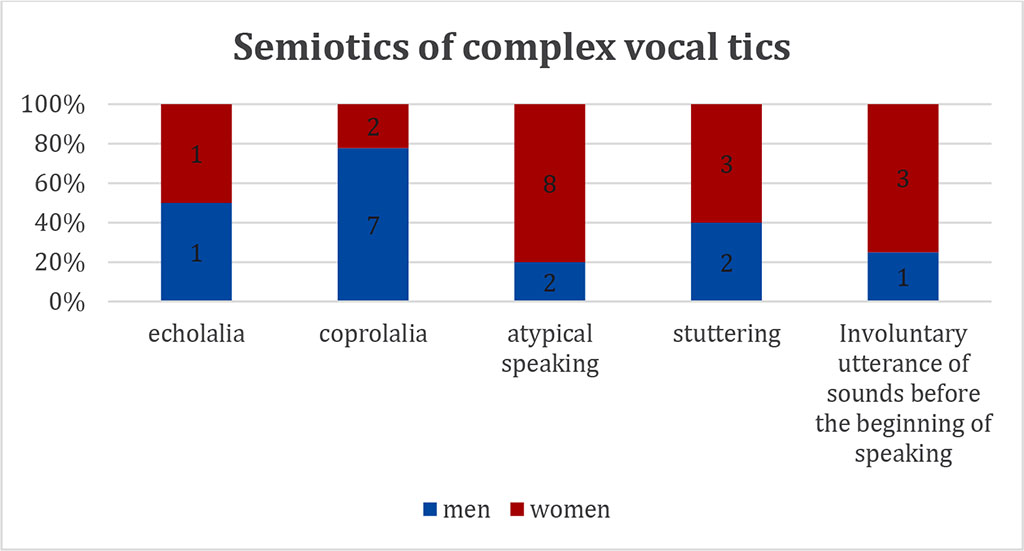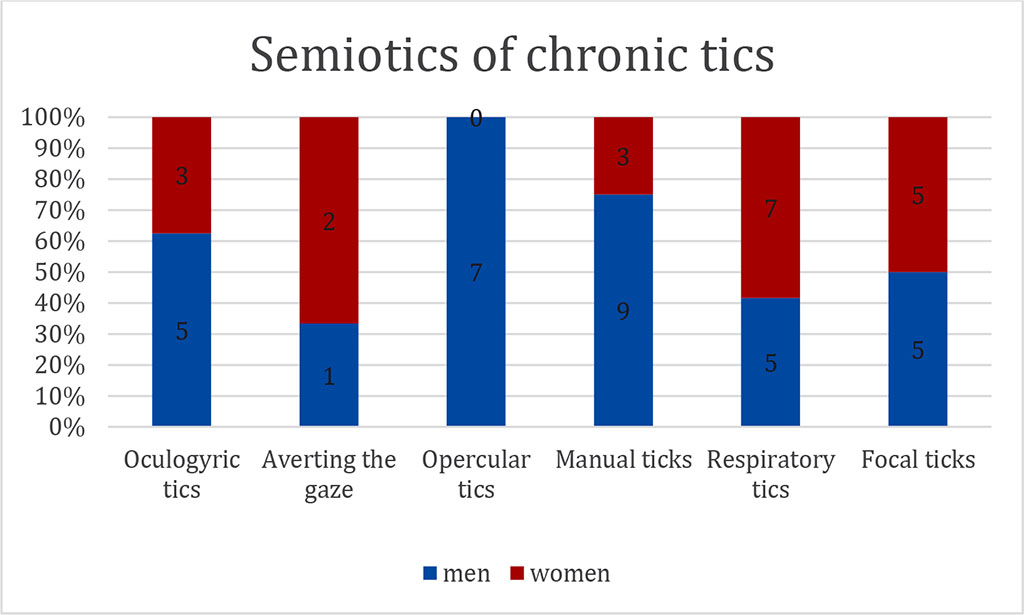- Home
- About the Journal
- Peer Review
- Editorial Board
- For Authors
- Reviewer Recognition
- Archive
- Contact
- Impressum
- EWG e.V.
Cite as: Archiv EuroMedica. 2024. 14; 6. DOI 10.35630/2024/14/6.605
The clinical picture of tics and hyperkinesis manifested by involuntary movements and/or sounds is relevant primarily due to its impact on the quality of life and social adaptation of people, especially during their studies and early careers. To analyze tics in young people, we examined 80 people (37 women (46.3%) and 43 men (53.7%)), first-year students of a medical university aged 17 to 19 years without complaints and clear anamnestic indications of tic hyperkinesis during the routine educational process. Along with the standard clinical and neurological examination, we assessed hyperkinesis during 32 academic lectures lasting 90 minutes once a week for 2 semesters. Tics and hyperkinesis were detected in 38.7% of men and women aged 17-19 without complaints and clear anamnestic indications of tic hyperkinesis during the routine educational process (men - 64.5%, women - 35.5%). The most common tics were facial tics (35.1%), oculomotor disorders (21%) and smirking (15%). Sexual dimorphism of tics in first-year students aged 17-19 during the routine educational process was revealed in the predominance of motor tics and chronic tic disorders in men, and simple and complex vocal tics in women.
Keywords: tics, hyperkinesis, sexual dimorphism of tics, routine educational process, first-year students
The clinical picture of tics and hyperkinesis, manifested by involuntary movements and/or sounds, is relevant primarily due to its impact on the quality of life and social adaptation of people, especially during the period of studies and early careers. Tics and hyperkinesis can lead to difficulties in communication, study, work, and also cause stress and psychological problems [1]. In addition, tics and hyperkinesis, having a genetic nature, are associated with neurological and mental disorders: Tourette syndrome, attention-deficit/hyperactivity disorder, autism [2]. In modern society, attention to this problem is increasing, and therefore research in the field of tics and hyperkinesis is becoming increasingly in demand in order to maintain the health and well-being of the younger generation [3]. Focusing on the problem of tics and hyperkinesis is an important step in understanding and effectively managing these conditions to ensure a better quality of life and well-being of patients [4, 5].
The purpose of the study was to identify tic hyperkinesis in young men and women, 17-19 years old, first-year students, during the routine educational process.
To analyze tics in young people, we examined 80 people (37 women (46.3%) and 43 men (53.7%)), aged 17 to 19 years, first-year students of a medical university, without complaints and clear anamnestic indications of tic hyperkinesis. Each subject gave their voluntary consent to participate in the experiment. The study was conducted during the routine educational process. All subjects underwent physical and clinical-neurological examination, manual and psychological testing [6-8].
Manifestations of hyperkinesis were also assessed and recorded once a week during 32 academic lectures lasting 90 minutes for 2 semesters.
In the tic kinematics, we distinguished clonic (fast) and dystonic (slow) hyperkinesis. Fast (clonic) tics were represented by blinking, shoulder jerking, mouth twitching and nose wrinkling, contraction of the abdominal muscles, hands twitching [1]. Slow (dystonic) tics manifested themselves in the form of squinting, shoulder shrugging, head twist, mouth opening with jaw protrusion, grimacing, throwing back the head, shoulder movements - adduction of the shoulders, throwing the arm sideways, flexion and extension of the hand and fingers [9]. In our observations, we considered the topical and clinical manifestation of tics and their severity [3-9].
Tic hyperkinesis was detected in 31 (38.7%) students (20 men (64.5%) and 11 women (35.5%) (Fig. 1-4).
Semiotics of motor tics was represented by the following phenomena: quick blinking – 7 cases (8.8%): 4 (57.4%) men and 3 (42.9%) women; blepharospasm – 4 cases (5.0%): 2 (50.0%) men and 2 (50.0%) women; mouth twitching – 3 cases (3.8%): 2 (66.7%) men and 1 (33.3%) woman; head twist – 3 cases (3.8%): 1 (33.3%) man and 2 (66.7%) women; nose wrinkling – 6 cases (7.5%): 4 (66.7%) men and 2 (33.3%) women; arms flexion and extension – 3 cases (3.8%): all 3 (100%) men; wrist twisting – 6 cases (7.5%): 4 (66.7%) men and 2 (33.3%) women; shoulder shrugging – 2 cases (2.5%): both 2 (100%) men; eyes shifting – 6 cases (7.5%): 2 (33.3%) men and 4 (66.7%) women; finger tapping on the table – 7 cases (8.8%): 6 (85.7%) men and 1 (14.3%) woman; mouth opening and closing (repeatedly) – 4 cases (5.0%): 1 (25.0%) man and 3 (75.0%) women; finger snapping – 4 cases (5.0%): 3 (75.0%) men and 1 (25.0%) woman; eyelid twitch – 4 (5.0%) cases: 1 (25.0%) man and 3 (75.0%) women; hopping – 2 (2.5%) cases, both 2 (100%) men; leg twitching – 3 (3.8%) cases: 2 (66.7%) men and 1 (33.3%) woman; involuntary tongue movements – 2 (2.5%) cases: both 2 (100%) women; chewing – 5 (6.3%) cases: 3 (60.0%) men and 2 (40.0%) women; touching the mouth area – 3 (3.8%) cases: 1 (33.3%) man and 2 (66.7%) women; lower lip twitching – 4 (5.0%) cases: 2 (50.0%) men and 2 (50.0%) women; smirking – 12 (15.0%) cases: 7 (58.3%) men and 5 (41.7%) women.
The semiotics of simple vocal tics was represented by the following phenomena: whistling – 3 (3.8%) cases, all 3 (100%) men; semi-cough – 5 (6.3%) cases: 2 (40%) men and 3 (60%) women; snorting – 9 (11.3%) cases: 3 (33.3%) men and 6 (66.7%) women; clicking the tongue – 4 (5.0%) cases: 1 (25.0%) man and 3 (75.0%) women; coughing – 2 (2.5%) cases, both 2 (100%) men; sniffling – 8 (10.0%) cases: 3 (37.5%) men and 5 (62.5%) women.
The semiotics of complex vocal tics was represented by the following phenomena: echolalia – 2 (2.5%) cases: 1 (50%) man and 1 (50%) woman; coprolalia – 9 (11.3%) cases: 7 (77.8%) men and 2 (22.2%) women; atypical speech – 10 (12.5%) cases: 2 (20.0%) men and 8 (80.0%) women; stuttering – 5 (6.25%) cases: 2 (40.0%) men and 3 (60.0%) women; emitting involuntary sounds before the start of speech – 4 (5.0%) cases: 1 (25.0%) man and 3 (75.0%) women.

Fig. 1. Semiotics of motor tics.
Chronic tic disorders manifested themselves as follows. Oculogyric tics were revealed in 8 of 31 persons (25.8%) (5 (62.5%) men, 3 (37.5%) women). Blepharospasm and eyes shifting were the most common phenomenological manifestations in patients with simple oculogyric tics (3 of 8 patients (37.5%: (1 (33.3%) man, 2 (66.7%) women). The average duration of oculogyric tics was 699 ms (range 299-32,500 ms). More often, oculogyric tics were accompanied by other dystonic tics (limb jerks, grimaces, head twist).
Opercular tics were detected in 7 of 31 people (22.6%), all of them young men, and became more frequent at the moment of mental stress.
Manual tics were detected in 12 of 31 people (38.7%) (9 (75.0%) men, 3 (25.0%) women) and were repeated as a “ritual” every 15-20 minutes.

Fig. 2. Semiotics of simple vocal tics.

Fig. 3. Semiotics of complex vocal tics.

Fig. 4. Semiotics of chronic tics.
Respiratory tics were detected in 12 of 31 people (38.7%), and became more frequent when focusing attention on the patient (5 (41.7%) men, 7 (58.3%) women).
Focal tics were detected in 10 of 31 people (32.3%) (5 (50%) men, 5 (50%) women).
Our results are consistent with consistent with findings from multiple studies, indicating that tics and hyperkinesis are less obvious in women and can be masked by other disorders [1-9]. Our results also confirm that in men, tics, both motor and vocal, are more often pronounced and varied [10-12].
However, we did not find any accessible works with data on the identification of tic hyperkinesis in young men and women aged 17-19 years during the routine educational process.
Thus, the obtained results showed that a significant part – 38.7% – of young people aged 17-19 years without complaints and clear anamnestic indications of tic hyperkinesis during the routine educational process have certain manifestations of tics and hyperkinesis. Moreover, young men suffer more often (64.5% of cases), than women (35.5% of cases).
The most common dystonic tics were oculomotor disorders (21%), smirking (15%), and blepharospasm (5%). Facial tics (35.1%) and quick blinking (8.8%) were the most common clonic tics.
The authors found a predominance of motor tic phenomena in young men (19 phenomena out of 45 cases were men, 17 phenomena out of 33 cases were women); tics of flexion-extension of arms, shoulder shrugging and hopping were noted only in men, and tics of involuntary tongue movements – only in women.
The data obtained revealed a higher frequency of simple vocal tics and complex vocal tics in women (11 phenomena out of 27 cases – men, 9 phenomena out of 34 cases – women). Although men had whistling and coughing, and women did not. Snorting and atypical speech clearly prevailed in women, and coprolalia in men.
The authors found a predominance of chronic tic disorders in men (6 phenomena out of 32 cases – men, 5 phenomena out of 20 cases – women).
Tics and hyperkinesis were detected in 38.7% of young men and women aged 17-19 years without complaints and clear anamnestic indications of tic hyperkinesis during the routine educational process (men - 64.5%, women - 35.5%). The most common tics were facial tics (35.1%), oculomotor disorders (21%) and smirking (15%). Sexual dimorphism of tics during the routine educational process was revealed in the form of predominance of motor tics and chronic tic disorders in men, and simple vocal tics and complex vocal tics in women.